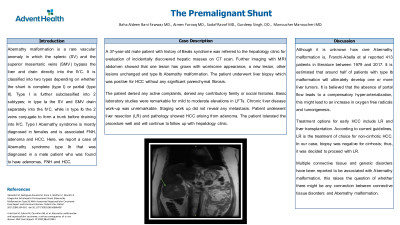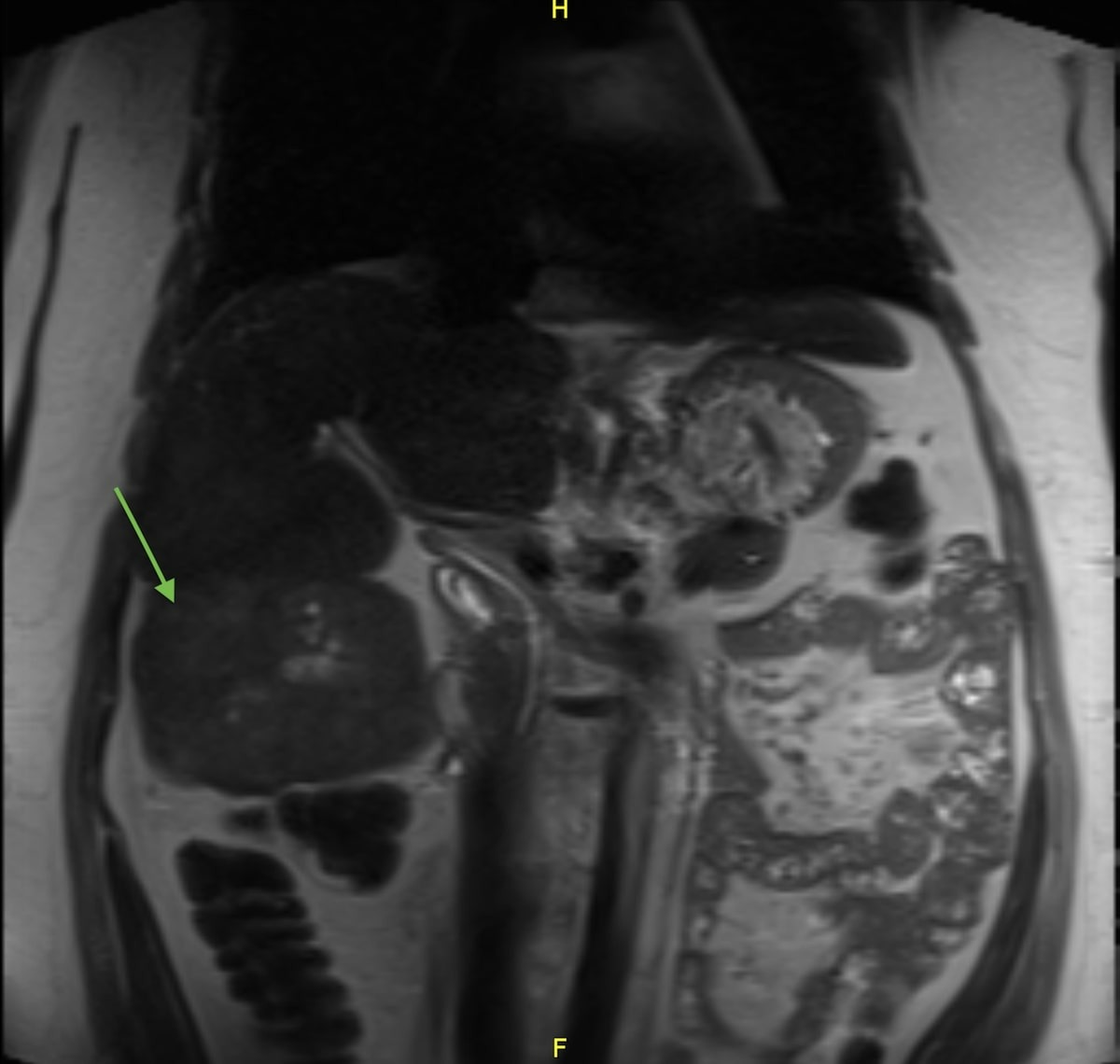Back


Poster Session D - Tuesday Morning
Category: Liver
D0545 - The Premalignant Shunt
Tuesday, October 25, 2022
10:00 AM – 12:00 PM ET
Location: Crown Ballroom

Has Audio

Baha Aldeen Bani Fawwaz, MBBS
AdventHealth Orlando
Orlando, FL
Presenting Author(s)
Baha Aldeen Bani Fawwaz, MBBS, Aimen Farooq, MD, Sadaf Raoof, MD, Gurdeep Singh, DO, Manoucher Manoucheri, MD
AdventHealth Orlando, Orlando, FL
Introduction: Abernathy malformation is a rare vascular anomaly in which the splenic (SV) and the superior mesenteric veins (SMV) bypass the liver and drain directly into the IVC. It is classified into two types depending on whether the shunt is complete (type I) or partial (type II). Type I is further subclassified into 2 subtypes; in type Ia the SV and SMV drain separately into the IVC, while in type Ib the 2 veins conjugate to form a trunk before draining into IVC. Type I Abernathy syndrome is mostly diagnosed in females and is associated FNH, adenoma and HCC. Here, we report a case of Abernathy syndrome type Ib that was diagnosed in a male patient who was found to have adenomas, FNH and HCC.
Case Description/Methods: A 37-year-old male patient with history of Beals syndrome was referred to the hepatology clinic for evaluation of incidentally discovered hepatic masses on CT scan. Further imaging with MRI abdomen showed that one lesion has grown in size with worrisome appearance, a new lesion, other lesions unchanged and type Ib Abernathy malformation. The patient underwent liver biopsy which was positive for HCC without any significant parenchymal fibrosis. The patient denied any active complaints,denied any contributory family or social histories.Basic laboratory studies were remarkable for mild to moderate elevations in LFTs.Chronic liver disease work-up was unremarkable.Staging work up did not reveal any metastasis.Patient underwent liver resection (LR) and pathology showed HCC arising from adenoma.The patient tolerated the procedure well and will continue to follow up with hepatology clinic.
Discussion: Although it is unknown how rare Abernathy malformation is, Franchi-Abella et al reported 413 patients in literature between 1979 and 2017. It is estimated that around half of patients with type Ib malformation will ultimately develop one or more liver tumors. It is believed that the absence of portal flow leads to a compensatory hyper-arterialization, this might lead to an increase in oxygen free radicals and tumorigenesis. Treatment options for early HCC include LR and liver transplantation. According to current guidelines, LR is the treatment of choice for non-cirrhotic HCC. In our case, biopsy was negative for cirrhosis; thus, it was decided to proceed with LR. Multiple connective tissue and genetic disorders have been reported to be associated with Abernathy malformation, this raises the question of whether there might be any connection between connective tissue disorders and Abernathy malformation.

Disclosures:
Baha Aldeen Bani Fawwaz, MBBS, Aimen Farooq, MD, Sadaf Raoof, MD, Gurdeep Singh, DO, Manoucher Manoucheri, MD. D0545 - The Premalignant Shunt, ACG 2022 Annual Scientific Meeting Abstracts. Charlotte, NC: American College of Gastroenterology.
AdventHealth Orlando, Orlando, FL
Introduction: Abernathy malformation is a rare vascular anomaly in which the splenic (SV) and the superior mesenteric veins (SMV) bypass the liver and drain directly into the IVC. It is classified into two types depending on whether the shunt is complete (type I) or partial (type II). Type I is further subclassified into 2 subtypes; in type Ia the SV and SMV drain separately into the IVC, while in type Ib the 2 veins conjugate to form a trunk before draining into IVC. Type I Abernathy syndrome is mostly diagnosed in females and is associated FNH, adenoma and HCC. Here, we report a case of Abernathy syndrome type Ib that was diagnosed in a male patient who was found to have adenomas, FNH and HCC.
Case Description/Methods: A 37-year-old male patient with history of Beals syndrome was referred to the hepatology clinic for evaluation of incidentally discovered hepatic masses on CT scan. Further imaging with MRI abdomen showed that one lesion has grown in size with worrisome appearance, a new lesion, other lesions unchanged and type Ib Abernathy malformation. The patient underwent liver biopsy which was positive for HCC without any significant parenchymal fibrosis. The patient denied any active complaints,denied any contributory family or social histories.Basic laboratory studies were remarkable for mild to moderate elevations in LFTs.Chronic liver disease work-up was unremarkable.Staging work up did not reveal any metastasis.Patient underwent liver resection (LR) and pathology showed HCC arising from adenoma.The patient tolerated the procedure well and will continue to follow up with hepatology clinic.
Discussion: Although it is unknown how rare Abernathy malformation is, Franchi-Abella et al reported 413 patients in literature between 1979 and 2017. It is estimated that around half of patients with type Ib malformation will ultimately develop one or more liver tumors. It is believed that the absence of portal flow leads to a compensatory hyper-arterialization, this might lead to an increase in oxygen free radicals and tumorigenesis. Treatment options for early HCC include LR and liver transplantation. According to current guidelines, LR is the treatment of choice for non-cirrhotic HCC. In our case, biopsy was negative for cirrhosis; thus, it was decided to proceed with LR. Multiple connective tissue and genetic disorders have been reported to be associated with Abernathy malformation, this raises the question of whether there might be any connection between connective tissue disorders and Abernathy malformation.

Figure: MRI abdomen showing hepatic segment 5/8 lesion has significantly increased in size compared to last CT and likely
represents an adenoma with possibility of fat-containing hepatocellular carcinoma given its growth.
represents an adenoma with possibility of fat-containing hepatocellular carcinoma given its growth.
Disclosures:
Baha Aldeen Bani Fawwaz indicated no relevant financial relationships.
Aimen Farooq indicated no relevant financial relationships.
Sadaf Raoof indicated no relevant financial relationships.
Gurdeep Singh indicated no relevant financial relationships.
Manoucher Manoucheri indicated no relevant financial relationships.
Baha Aldeen Bani Fawwaz, MBBS, Aimen Farooq, MD, Sadaf Raoof, MD, Gurdeep Singh, DO, Manoucher Manoucheri, MD. D0545 - The Premalignant Shunt, ACG 2022 Annual Scientific Meeting Abstracts. Charlotte, NC: American College of Gastroenterology.
